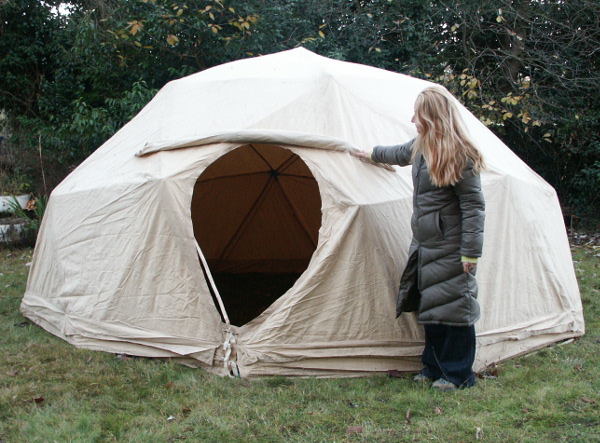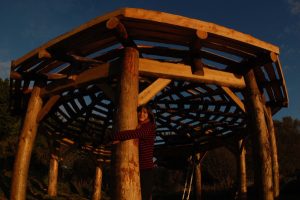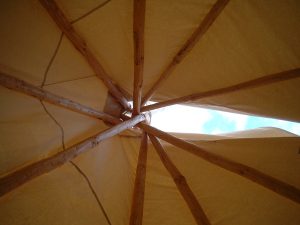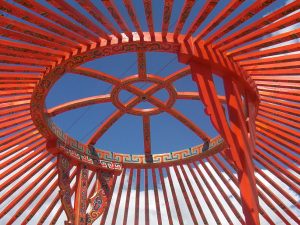Geodesic domes - introduction

“The strongest, lightest and most efficient means of enclosing space yet known.” – American Institute of Architects
Contents
What are geodesic domes?
The word geodesic relates to lines drawn between points on a sphere or a curved surface. So to picture a geodesic dome, think of a sphere (or half a sphere) with some dots on it, with the dots connected with straight lines making triangles (usually), and the sphere removed. Here’s an image of a classic geodesic dome frame.

Classic geodesic dome frame (showing triangles).
It’s often thought that Buckminster Fuller invented the geodesic dome, but he didn’t, although he coined the term. They were actually invented by Walter Bauersfeld, around 1920 in Germany. ‘Bucky’ Fuller was at the forefront of a little post-WW2 explosion of interest in mathematically-designed structures, and he designed many famous domes such as the Union Tank Car Dome – over 100 metres in diameter – used for repairing railway cars in the 1950s, that has since been demolished. The maths of large domes was the biggest challenge, and it was where Fuller excelled, using trigonometry, in an age without computer modelling.
More modern examples include Spaceship Earth at the Epcot Centre, and the Eden Project. Domes are perfect for large structures required to encompass a lot of volume. They can be found all over the world, with perhaps the greatest concentration being found in North America.
The story of Buckminster Fuller’s Union Tank Car Dome.
Geodesic domes can have many small-scale uses, from temporary accommodation or an extra room outside the house, summerhouse, workshop, storage space, children’s playhouse, meeting room, spare bedroom, study area, sauna, meditation retreat, travelling tent, etc.
What are the benefits of geodesic domes?
Strength: triangulation gives huge strength.
Energy and resource efficiency: domes represent the lowest material use for the largest volume (as long as there’s no wastage when you’re cutting triangles), which means the smallest surface area per unit of volume, and therefore minimum heat loss.

Giant geodesic biomes housing tropical rainforest at the Eden Project in Cornwall. Notice the tiny people in the foreground.
Wind resistance: wind flows over and around a dome smoothly, without causing damage; and they offer the same profile for any wind direction – so they’re excellent for windy locations.
Simplicity: although they may look complicated, once you’ve got the hang of it, there are far fewer different components with a geodesic dome structure. For example, a typical rectangular home will have vertical, straight walls, windowsills, lintels, sloping roofs, fascias, gable ends etc., but a geodesic dome could be made of the same components, repeated across the entire structure. Plus, a dome kit could be put together by someone with very little experience of conventional building.
How to build a model geodesic dome with paper.
Space: the open span surprises people when they first walk inside one; they definitely have the ‘wow’ factor.
Downsides: they’re maybe not so fantastic as a typical, three-bedroom family home that needs to be divided into smaller rooms, because really, they’re the wrong shape. They’re much better for spanning a clear space. So great for a single person or a couple who want to live in one large space.
They also have a reputation for being leaky, but that’s almost definitely because conventional builders / roofers weren’t prepared to work on early models, and so enthusiastic but inexperienced amateurs had a go, with predictable results in many cases. Geodesic domes don’t leak if they’re built well.

Frame for a geodesic tent, that can also be used as a children’s climbing frame.
What can I do?
Types of dome
You can have a go at making a model first. And if you’re fascinated by the maths behind it, you’re going to have a lot of fun.
You could then graduate to a tent. Geodesic dome tents work well, because you can assemble and disassemble reasonably easily, for sturdy mobile accommodation. You could also make all the struts and connectors yourself, from natural materials and from bits of kit you might have lying around in a shed. We have a guide to making your on dome tent. The canvas is trickier – you have various options, and there are canvas manufacturers to help you; but even without a canvas, you’ll have gained experience and ended up with a kiddie’s climbing frame!
‘Unity Dome’, built by our advisor Paul Robinson. It has a flat base, and can be attached to a house as an extra room. The triangles are designed to be cut from an 8×4 sheet of any material, with no waste.
Greenhouses are good as domes too, as they’re less likely to be damaged by wind, and they lose less heat at night.
Geodesic dome houses, as mentioned, might not work that well for families, but are fine for singles or couples – as part of the ‘tiny house’ trend; but if you decide to go for it, you’ll then have the problem of building regs (which you don’t need for a workshop, garage, or something you’re not going to be living in). The building regulations system is quite inflexible, so anything out of the ordinary is quite difficult to get through.
As their structures are so strong, they work quite well underground, and don’t require heavy trusses to take the weight of the overfill.

Geodesic dome greenhouse.
Building a dome
An introduction like this is too short for detailed instructions for building a geodesic dome house, but there’s lots of information out there, including detailed tutorials and plans, many of them free. See our links page, search online and look for instructional videos on YouTube. There are many different styles and shapes, and innovations are emerging all the time – for example the beveled frame method removes the need for a joint, with a hole, where the tips of triangles meet. This is perhaps the simplest way to build, although you’ll need a table saw with a tilt function, to cut the bevel angles.

One method of connecting poles for a home-made geodesic tent frame.
Frequency is an important concept to understand if you’re thinking of building a dome. Most domes are based on an icosahedron shape, with 20 faces. This is a ‘one-frequency’ dome, and is a bit ‘boxy’ rather than spherical. A two-frequency dome will make this shape more spherical, by adding more triangles. Imagine a single triangle, with a dot in the middle of each side. Join up these dots to create another triangle (upside down) inside the first one (more information here and here). Frequency (and therefore complexity) tends to increase with the size of the dome, to keep panel sizes manageable. A three-frequency dome is the most common.
15 examples of dome homes around the world (although maybe some of them are a bit too large to be truly ‘eco’).
Domes can be coated with a waterproof sealer, with a drip-sheet behind the outer skin, so any moisture that managed to get through would run to the bottom and out. There’s then an air gap, then insulation and interior walls. You can have ordinary timber studwork and plasterboard on the inside. A tiny wood stove should keep even a large dome toasty on the coldest winter day.

Paul Robinson inside his 2-storey, 7-metre diameter geodesic dome garden office; it cost £5000 in total (£1k for the aluminium panels, cut to shape). It has no structural struts or beams – the 1.6 gauge (1.6mm thick) triangular panels are riveted together, and support themselves. Paul can easily walk on the roof, which would be impossible for any other unsupported structure of this size. Paul said: ‘I thought it would work, but I didn’t imagine it would be this strong’.
If you enjoy building domes, there’s huge demand for garden offices and glamping pods. So start small, get the hang of it, build things that you can take down and sell, and you could get yourself an interesting career in dome-building and designing. And if you don’t enjoy it, well, you can find geodesic dome designers / builders / suppliers online.
Specialist(s)
Thanks to Paul Robinson of Geo-Dome for information.
The specialist(s) below will respond to queries on this topic. Please comment in the box at the bottom of the page.
 Paul Robinson has built many kinds of geodesic dome, including the 2-storey home office in his garden. He runs Geo-Dome.co.uk, where he provides tons of information, plans and a portfolio of his projects. He also has a Youtube channel with lots of useful instructional videos.
Paul Robinson has built many kinds of geodesic dome, including the 2-storey home office in his garden. He runs Geo-Dome.co.uk, where he provides tons of information, plans and a portfolio of his projects. He also has a Youtube channel with lots of useful instructional videos.




3 Comments
The geodesic domes are great conceptually and spectacular for the large projects but surely with most furniture suiting a linear venacular, it’s going to be tricky for avg Joe to find anything to fit?
It was really informative when you talked about how geodesic domes can be used as a summer house or even a workshop. I want to have a workshop built on my property so that I can have my own space for my projects. It seems like it would be a good idea for me to consider having a geodesic dome built on my property. https://domeincorporated.com/residential-domes/
Has anyone ever made a coffee cafe in a smallish dome maybe 5 meters in radius